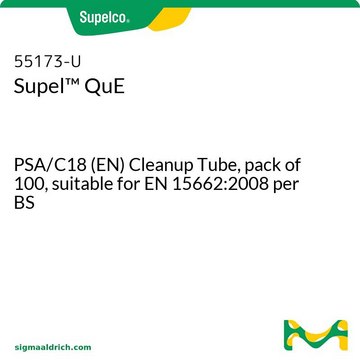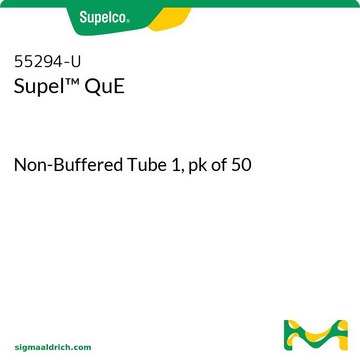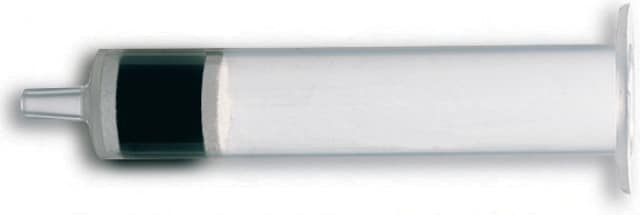55174-U
Supel™ QuE QuEChERS tube
PSA/ENVI-Carb™ (EN) Cleanup Tube 1, pack of 100, suitable for EN 15662:2008 per BS
Synonym(s):
QuEChERS
About This Item
Recommended Products
product name
Supel™ QuE, PSA/ENVI-Carb™ (EN) Cleanup Tube 1, pack of 100, suitable for EN 15662:2008 per BS
agency
suitable for BS EN 15662:2008
Quality Level
composition
magnesium sulfate, 150 mg
Supelclean™ ENVI-Carb™, 2.5 mg
Supelclean™ PSA, 25 mg
packaging
pack of 100
technique(s)
QuEChERS: suitable
centrifuge tube volume
2 mL
application(s)
food and beverages
Looking for similar products? Visit Product Comparison Guide
Related Categories
General description
Using the QuEChERS method, food/agricultural samples are first extracted with an aqueous miscible solvent (e.g., acetonitrile) in the presence of high amounts of salts (e.g., sodium chloride and magnesium sulfate) and/or buffering agents (e.g. citrate) to induce liquid phase separation and stabilize acid and base labile pesticides, respectively. Upon shaking and centrifugation, an aliquot of the organic phase is subjected to further cleanup using SPE. Unlike traditional methods using SPE tubes, in dispersive SPE, cleanup is facilitated by mixing bulk amounts of SPE (e.g., Supelclean PSA, ENVI-Carb, and/or Discovery DSC-18) with the extract. After sample cleanup, the mixture is centrifuged and the resulting supernatant can either be analyzed directly or can be subjected to minor further treatment before analysis.
Supelco carries a line of vials and centrifuge tubes containing pre-determined amounts of salts and SPE sorbents to support the most common method configurations used today.
Legal Information
Storage Class
13 - Non Combustible Solids
wgk_germany
WGK 1
flash_point_f
Not applicable
flash_point_c
Not applicable
Choose from one of the most recent versions:
Certificates of Analysis (COA)
Don't see the Right Version?
If you require a particular version, you can look up a specific certificate by the Lot or Batch number.
Already Own This Product?
Find documentation for the products that you have recently purchased in the Document Library.
Customers Also Viewed
Our team of scientists has experience in all areas of research including Life Science, Material Science, Chemical Synthesis, Chromatography, Analytical and many others.
Contact Technical Service









